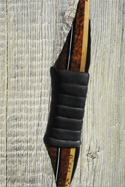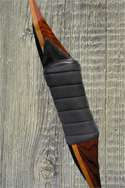|
Benefits
Both the HHC and the American Wolf
Longbows are built on the same order
of the take-down longbows, except
they are one-piece bows.
The American Wolf could be called a one-piece Black Wolf because
of
the similarity of design and materials application.
The HHC is a Hill style, commemorative longbow with set-back in the
limbs,
instead of the typical Reflex/Deflex common to my take-downs
and the American Wolf longbows.
Back to top
Exotic Hardwood
Riser
Building any longbow with exotic hardwood gives the finished product
a higher standard of quality and craftsmanship. It is the standard
in the industry. I use only high-grade materials that are busy in
color and figure. Raw stock is selected for me by my vendor and carefully
graded.
The riser sight-window is cut so the arrow rides 1/8 th inch off center.
This seems to produce the best arrow performance. The shelf or rest
is cut to form a radius from back to belly. The strike plate is cut
to form a radius from back to belly. Both surfaces are covered with
leather. Where the two radii meet the arrow makes contact with the
bow. This geometry seems to produce the best arrow performance. By
making sure to keep the leading edge of the fletching smooth on all
arrows shot out of these bows the life of the arrow rest is unlimited.
Proper waxing and oiling keeps the leather arrow rest and strike plate
in good condition for the life of the bow.
Back
to top
Bamboo Core
Limbs
Bamboo has higher elasticity with adequate compression strength, and
less physical weight than any wood that can be used to build a longbow.
Bamboo is a grass that grows with very straight, strong grain.
It was no accident that fly-rod builders began using bamboo in the
construction of high-dollar, split-bamboo rods. Because of its cast
and elasticity, it set the standard for sport fishermen around the
turn of the last century. FRP (Fiber Reinforced Plastic) replaced
the rods eventually, but, today craftsmen still use bamboo in custom
rods. Once I realized that the combination of bamboo and modern FRP
produced the best cast for my bows, I began using this combination
almost exclusively. Today, all my bows are built with bamboo lamination
in the limbs, backed with carbon. A combination of carbon and fiberglass
is laminated to the belly on the outside surface. These composite "skins" are ground very thin in order to optimize the highest
stress possible. When the bows are tillered, I avoid sanding down
the surfaces of the FRP to achieve balance between the top and the
bottom limb. The top limb lamination are ground 0.004 of an inch
thinner than the bottom limb lamination. This produces a bow with
a tiller between top and bottom limbs that varies by four pounds.
In other words, the top limb pulls four pounds less than the bottom
limb. This produces a "heavy chested" longbow. With this
design, any of my longbows will shoot a variety of differently spined
arrows well, including graphite, carbon, wood and aluminum.
My bamboo comes from Japan and it is tempered. The Japanese refer
to this as a "carbonizing" process. The effect produces
a more resilient and trouble free bow limb with a "sweet cast".
It also reduces handshock and the bows do not stack.
Back
to top
Carbon/Graphite
Backing FRP
Carbon/Graphite is the latest fiber reinforced plastic that is similar
to fiberglass. Carbon has higher elasticity than fiberglass in tension.
It has very high tensile strength and low physical weight. Backing
a bow limb with it enables the bowyer to increase tensile stress and
reduce the overall physical weight of the limb. The effect increases
the recovery rate of the bow, reduces stack and practically eliminates
handshock.
Back to top
Carbon/Graphite/Fiberglass Belly FRP
Carbon is much weaker in compression on the belly than fiberglass.
But, by "backing" it with fiberglass it gives strength
and
increases the amount of elasticity on the belly of the bow limb.
After
years of experimenting with this combination, I have not found anything
that compares. Limb stack and handshock are reduced, while smoothness,
cast and speed are increased.
Many people argue that carbon FRP does not contribute much to any
bow. This may be the case if the design and other factors are not
taken into consideration. However, any Black Wolf typically casts
arrows with the same speed and stability as a
recurve of equal weight. As often as not, the recurve can even pull
heavier and any of my bows will keep up in performance.
Back to top
Reflex/Deflex/Trapezoid
Limb Design
The Black Wolf and EL Lobo limb taper is 2:1 in overall length from
the riser to the tip. The limbs taper in length, width, thickness
and from the belly to the back. The back is 30% narrower than the
belly. The reason for all the tapering is to reduce physical mass.
Recurving the last third of the bow limb makes it possible to reduce
the limb mass even more, but, it also pre-stresses the limb so when
the bow is strung it has higher tension. Higher limb tension created
from reduced limb mass and the reflex limb design produces a faster
shooting bow. The Deflex helps reduce handshock because Deflex forces
the bow limbs to recover in an outward vector more than forward.
The
limbs of common longbows designed without Deflex recover more in
a
forward vector with the results of higher handshock. If the top limb
recovers in the opposite direction from the bottom limb, residual
vibration (handshock) from shooting an arrow is cancelled in the
riser
where the bow is held. Deflex directs handshock away from the riser
because the movement of the top limb is opposite the movement of
the
bottom limb.
Back
to top
FastfIight, Continuous Loop Bowstrings
When Fastflight was introduced to archery I started using it. I abandoned
Dacron Flemish twist strings as soon as I realized how much energy
I lost to twisted strings that stretch. I simply built the limb nocks
to handle the additional stress. Today, there are many different string
choices. I have found that FF is good enough. I do not use FF Flemish
twist strings on my bows. Twisting a string defeats the purpose of
using Fastflight. Any excessively twisted string stretches as the
bow is shot. Twisted strings absorb mechanical energy more than those
that are not twisted. Also, strings that stretch less create less
vibration. Strings that vibrate less reduce handshock and the painful
slap to the forearm.
Back
to top
Leather Handle
Wrap
The leather handle wrap I use on my bows is the same as the
leather wrapping on tennis rackets and golf clubs. Both activities
are intense and sweaty. These wraps take "buck fever" into
consideration and perform. They age beautifully with a minimum of
service. Any good leather treatment works on them to restore oils
and color.
Back
to top
|
HHC
This
full view photo shows the
HHC strung. Note the "Crescent" shape of the bow
instead
of the common D-shape of many Hill style longbows. By using
pre-stressed, tapered bamboo lamination in the core of the
bow the last one-third of the limbs are reflexed or recurved
in the bow form. The set-back creates a "whip-ended" bow
that has less mass and more cast. In combination with the
FRP carbon there is less weight in the limbs, which reduces
handshock. These bows are 66-inches in length with a 6
1/4" to
7 1/8" brace-height.
|

|
Both the HHC and the American Wolf longbows are designed and built for
those who do not need a take-down longbow.
The HHC honors the memory of Howard Hill, but, it is not a copy of
any
Hill bow on the market today. The riser is reminiscent of a Hill bow.
The limbs are an inspiration from Fred Anderson, and they are "whip-ended".
Whip-ended limbs are pre-stressed because of the tapered lamination
and the "recurved set-back or reflex" design in the last
third
of the limbs. This produces a physically lighter weight limb tip with
more power than one that is straight and parallel. With the reduced
weight and increased stress caused by the Carbon FRP, the bow shoots
with 75% less handshock than any Hill style longbow on the market today.
With the dramatic reduction in handshock and the quiet, smooth draw
the HHC is a classic, elegant longbow. It is made in a 66-inch length
only. It is priced right so anyone can afford to own one. It uses Fastflight,
continuous loop strings only. The handle is leather wrapped, similar
to any of my take-down longbows.
Back
to top
 |
American Wolf
With
a reflexed style limb, the
American Wolf is the same as the Black Wolf only in a one-piece
design. Both the American Wolf and the HHC is "Heavy Chested" with
the tiller of the top limb four pounds lighter in draw
than the bottom limbs. Each is designed to draw smoothly, with
no stack. Handshock is eliminated by the design and the materials
application. Both bows use continuous loop fastflight strings.
|
Cost/Warranty
Model |
Length |
Cost |
HHC |
66" |
$950 |
American Wolf |
62"-
68" |
$950 |
|
*Optional
rattlesnake skin backing: $200 materials/labor
*Limited warranty of 2 years against materials and workmanship
*Shipping/Handling: $35
|


 American Wolf
American Wolf


